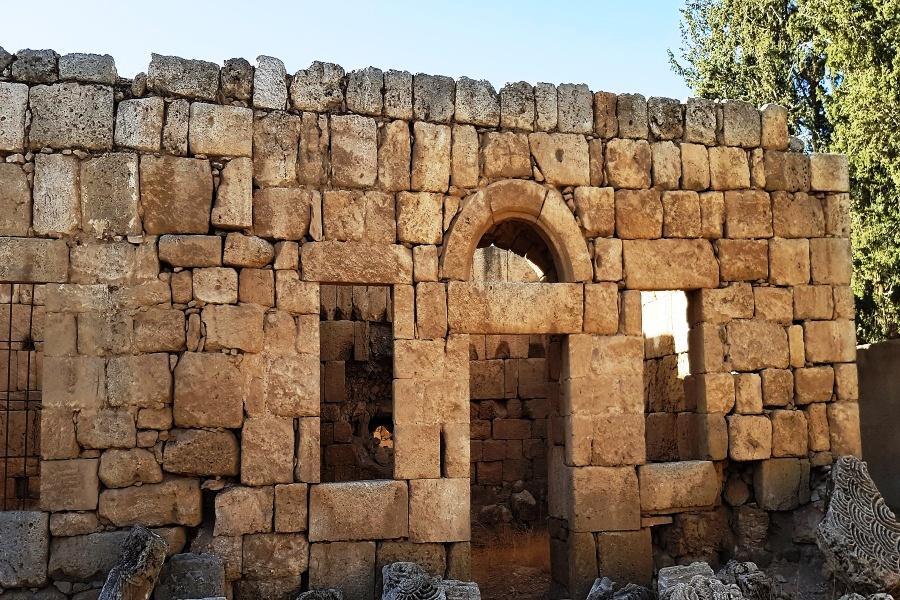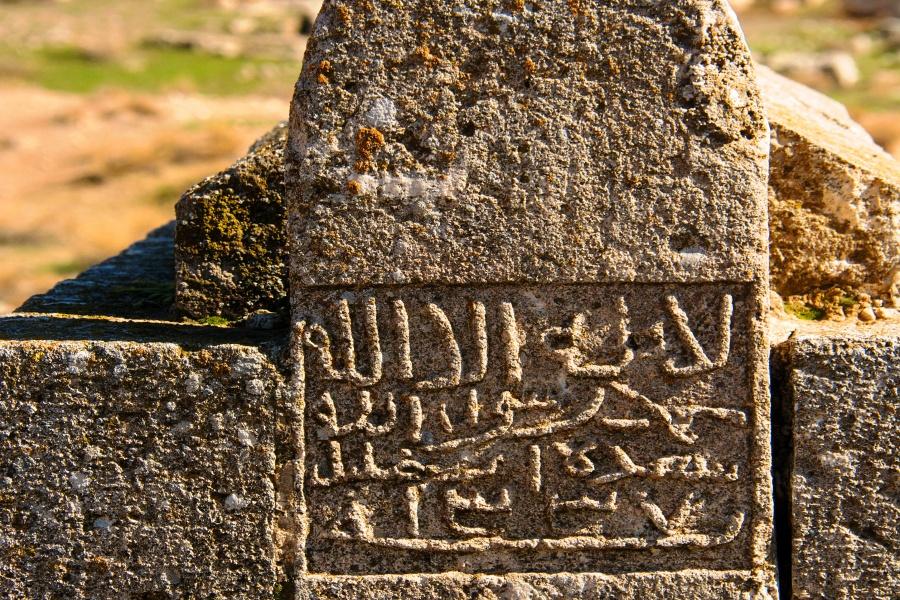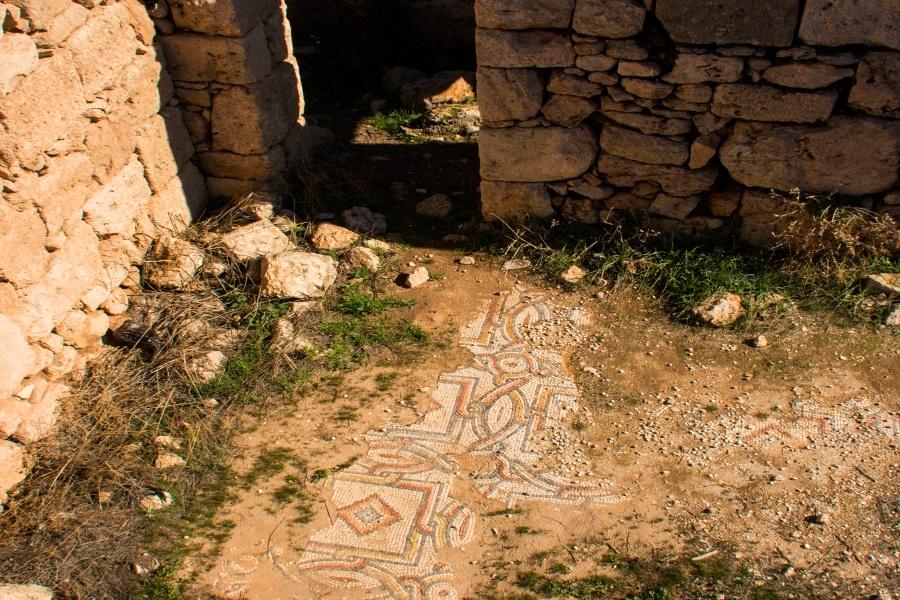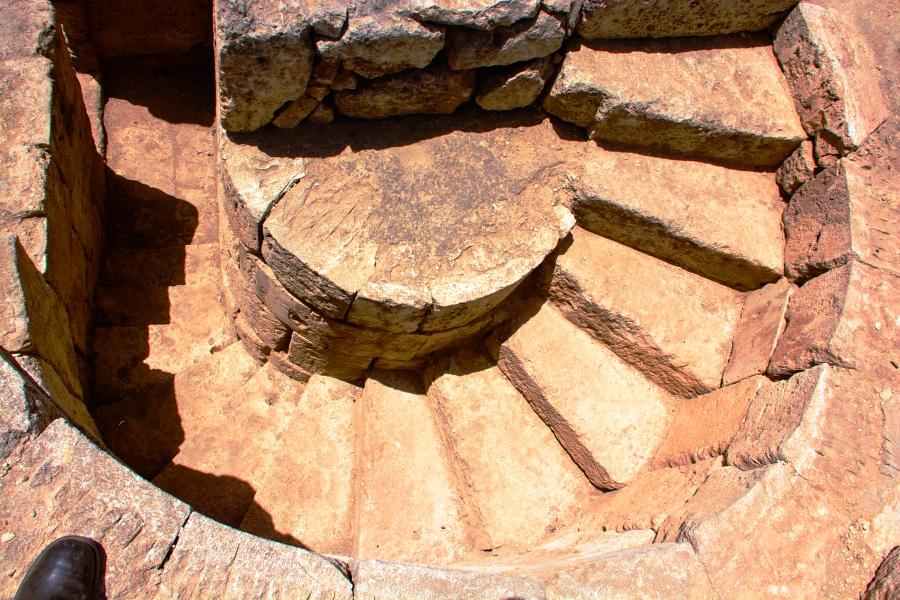+962 7 9635 8199
[email protected]
Al Qastal palace is one of the oldest and most complete Umayyad provincial communities in the Near East, as well as one of the best preserved. Information from UNESCO about World Heritage Site status of Al Qastal.
The remains at Al Qastal include a wide variety of sites such as the central palace, baths, a reservoir, a mosque, small houses, a cemetery—the oldest Muslim graveyard in Jordan—and a dam.
Unlike other Umayyad palaces and complexes in the region that were not completed, al-Qastal was completed and inhabited throughout the entire Umayyad period and part of the Abbasid period. In fact, while building Qasr Mushatta only five kilometers to the east, Caliph Walid II (743-44 AD) may well have resided in al-Qastal.
It is thought that the origin of the word Qastal is from the Latin “castellum” or small castle hinting at the possibility that the Umayyads built their complex on a Roman military structure.
In 2001, the Department of Antiquities of Jordan applied for recognition of this site as a World Heritage Site to UNESCO.
Submitted to UNESCO: Al Qastal (Settlement) Jordan
Date of Submission: 18/06/2001 Criteria: (i)(iii)(iv)
Category: Cultural
Submitted by: Ministry of Tourism and Antiquities. Department of Antiquities.
Coordinates: Utm East:778300 – Utm North:3516200 UTM Zone:36
Ref.: 1550


Al Qastal is a modem village of approximately 2,500 inhabitants, situated 25 km south of Amman, Jordan, on the Desert Highway near the Queen Alia International Airport.
The remains of the Umayyad complex, which include a qasr, mosque, early cemetery, reservoir, two dams, over fifty cisterns and a complex network of irrigation and catchment systems, are situated in the midst of the modern village.
Al Qastal is built of dressed limestone blocks, occasionally of megalithic size, with an alternation of one stone showing its long side and another one showing its short face, with a rubble core. The central palace forms a square measuring about 68 m to the side with 3-quarter round towers at the corners, and 3 semi-round towers on each side except the east entrance way. Originally, the palace is believed to have consisted of two stories, although the upper storey has not survived.

Qasr al-Qastal is part of a larger complex, which includes the qasr, a small and elaborate mosque, an extensive water system and probably a bath complex.
There is also a very early Islamic cemetery there, some of whose headstones bear the earliest known examples of Kufic script.
Al Qastal is enormous (70 x 70 m) and solidly built of ashlar-cut limestone. The stone was ornately carved; interior walls are covered with frescoed plaster and rich mosaics on both walls and floors, and like Qasr al-Hallabat, Qastal also has an elegant bath complex situated nearby.
The bath’s mosaics and marble-tiled floors, frescoed walls and carved stone are even richer than those of the qasr.
The bath complex is remarkably similar to that of Qusayr ‘Amra. All that remains of the original mosque is part of its minaret and west wall. It is also possible that a cistern in the former forecourt supplied an ablution fountain or pool. A nineteenth century British traveler drew the minaret at Qastal and described the building’s ‘perfection’ and the marble columns and carved capitals that flanked the Mihrab .

The Umayyad complex at al Qastal, has been well known since it was described in detail by Briinnow and Domaszewski in 1897-1898. An earlier British traveler, H.B. Tristram, thought the mosque at al-Qastal was a Greek temple. Briinnow and Domaszewski understood the complex as a Roman camp — a castellum and praetorium, but it has been generally consented to date to the Umayyad period since the work of Jean Sauvaget, who argued that the building previously interpreted as a temple or praetorium was actually a mosque.
Since Bainnow and Domaszewski’ s detailed documentation of the site, the mosque has been studied in the field by Heinz Gaube, Patricia Carlier and Frederic Morin and currently under the aegis of al-Qastal Conservation and Development Project (QCDP).
It is now clear that between Tristram’s description, published in 1873 and the present time, the mosque at al Qastal has been largely destroyed, rebuilt, and modified several times.

Scholars are still debating with regards to the date of the palace. Historical sources and certain stylistic features suggest 744 AD as the date of the palace completion. When al-Walid II visited the area in 743-4 AD, the palace was in existence. The layout of the palace (living quarters organized around courtyards) is very similar to other Umayyad palaces of this period, such as Qasr Kharraneh or Harraneh.
The palace is dated to the reign of Yazid II ibn Abd al-Malik (720-740 AD) based on a reference to a palace in a contemporary poem to Yazid written by Kuthayyir ibn Abd al-Rahman ‘Azza (644-723 AD). Moreover, the construction of the palace is very similar to others constructed under Yazid’s patronage, such as Qasr al-Muwaqqar and the Umayyad Palace on the Amman Citadel. It is worth noting, however, that the construction might have begun before the reign of Yazid II. The palace was converted into domestic quarters during the Ayyubid/Mamluk period (12th -16th century AD).
During the 1983 mission, the archaeological levels in the Entrance Hall were studied: The northern staircase is rising fourteen steps high. The southern one is blocked up by an undated wall, very carefully built with Umayyad blocks.
Outside, the large Umayyad tower was first dismantled or destroyed, and then completed with a structure, probably vaulted, built with Umayyad blocks —some of which are carved — creating an outer room.
The great number of AyyubidMamluk sherds, in addition to the remains of a hearth with a Mamluk pot (found in situ in the place of the missing north doorjamb), may indicate that this room was used during the Medieval Period. As there was no door between the outside room and the inside barrel-vault, it must be noted that the entrance of the palace changed.
The mosaics of the northern portico were in a very bad state of preservation, and only few parts were found. Although very similar, the pattern differs from the other mosaics. In the central part, the pattern is composed with circles only, drawn with the same colors, but here entangled.
The borders also differ: three stripes are braided, and the external side offers a carpet-border, using black, red and orange cubes. This last motif is also used for the borders in the apartments and the corridor leading to the latrines.
The same pattern, entangling circles, was also found by Musil and later by Creswell’ at Qusayr Amra, in the alcoves to the left and right of the central apse of the Audience Hall.
Immediately above the Umayyad pavement, which was preserved in a very bad condition, a very thin level including Umayyad, Abbasid and Medieval materials was found. The area of the eastern portico where mosaics were found was excavated .
The last level left after excavation —about 30 cm thick instead of 4m— was exclusively Medieval, but no level of occupation was recognized out of the simple reuse of the Umayyad mosaics, here protected with a stone bench and there affected by a fire. Numerous beam-holes noted in the highest part of the eastern wall of the courtyard may indicate the level of the Medieval roofing in this part, after the collapse or destruction of the Umayyad portico.
The mosaics of the eastern portico were cleared for the complete width of the portico, around five meters in width. Excepting a local destruction (around one square meter), it seems that this mosaic was entirely preserved (at least until October 1985).
The pattern is identical to the one uncovered during the 1983 mission at the southern portico (south-west corner) (see Fig. 5). The former has circles alternating with squares parallel to the walls, instead of the latter which mixes the same circles with smaller squares, turned 45°. The eight colors are the same, that is white, grey, black, red, pink, orange, yellow and light green, organized in colored stripes using five cubes, for example black, red, pink, white and black.

In this area, the surrounding wall and towers were completely destroyed, below the level of their foundations. The first course of the south wall, that is the wall immediately beside the courtyard, was partly preserved.
The cubes are about 8 mm wide, instead of the 15 mm width for the mosaics of the porticoes or the other apartments, and more than twelve colors may be noted: white, two greys, black, red, pink, orange, yellow, several yellows and browns, two blues, green.
The borders are divided into three parts.
The outer one reused the carpet-border already mentioned at the northern portico. The middle part is composed of entangled circles, using white, grey, black, red, orange, yellow and yellowish cubes. The inner part offers a red ground, on which appear white squares and polychrome circles, including white, blue, black, yellow and red cubes .
In the central area, the pattern is very complex, entangled large squares. In these squares octagons or circles of different sizes were placed, each ornamented with a rosette, a flower, a leaf or a fruit, painted with a minimum of eight colors.
Around the brink of the cistern and excavated in the stone pavement, a small canal ran, collecting the waters from the courtyard and from the upper part of the brink itself. There was a water collector, filled with sand. Two glass mosaic cubes were found in this level, one with gold. On the upper face of this level was an Umayyad pot, found crushed in situ (in some 190 pieces), mixed with other Umayyad sherds and stone mosaic cubes.
According to Abu’l Faraj al-Isfahani, who wrote three centuries afterwards’ and al-Tabari, the Khalif al-Walid II and his cousin al-`Abbas stayed at Qastal, that would have been between 743 and 745: the palace —including the courtyard— is supposed to have been cleaned at that time.
The Umayyad pot may have been crushed by some falling blocks: Briinnow and Domaszewski mentioned the remains of a collapsed structure in the center of the courtyard.
It is well known that the country was affected by an important earthquake, around the year 747. This earthquake may have been the origin of the collapse, as well as the usually supposed destructions at the end of the Umayyad Period.

Two Mihrabs can be seen: the latest is a circular niche, roughly built and reusing the original Milirab: a rectangular recess 0.45m deep (one Umayyad Cubit) and 1.80m wide (4 Umayyad Cubits).
A small trench was opened in the courtyard, beside the late western door, but the stratigraphy was recent in this part. The level of the Umayyad floor was not reached.
From the architectural study, it appears that the prayer room was first opened on the courtyard, through three arches: their springings are still in place, and the keystones can be seen around the mosque.
The mosque at Qastal differs from the other mosques built around the Umayyad palaces: here, the prayer room is not deep (only one row —as at Qasr el-klayr el-Gharbi— instead of two at Jabal `Usays and three everywhere else); there is a minaret (including stairs), the original Mihrab was a rectangular recess, and the Qibla wall is not perpendicular to the direction of Mekkah: the error is 29° West.
The dam is located half a kilometre east of the palace. Oriented northeast/ southwest, the remains of the wall are 400m long, and Wadi al Qastal had gone round by the northern end of the wall. Today, the waters of Wadi al Qastal are collected through a wide surface, exceeding 70 square kilometres.
A cross-section was made in the northern part of the dam. Very carefully built of large ashlar in headers and stretchers, the wall is 4.30m wide, the central part is filled with masonry. The two first courses offer a recess, 12cm on the west side and 15/17cm on the east side of the wall. Then, the base of the wall is 4.86 m wide.
Underneath is the foundation, 85cm wider than the wall on the west side, that means that the total width of the foundation may exceed 6.56m. At that place, the total height of the remains is 2.19m: most of the wall was dismantled by the Ottomans for the construction of the Hijaz Railway.

The minaret has a cylindrical shaft 5.00m in diameter and rests on a rectangular base of three courses, 1.35m high, measuring 2.55m from the south, 5.00m from the west, 4.95m from the north and 2.57m from the east. The shaft consists of six courses 3.27m high, a projecting molded cornice marks the beginning of the second storey and serves as a base for the channeled Corinthian pilasters. Although only six pilasters have been recovered, it seems that originally ten such pilasters stood on the cornice.
The masonry of the minaret that consists of fine ashlar laid randomly in header-and-stretcher fashion with tight joints indicated by a thin, slightly projecting plaster pointing is exactly like the exposed masonry of the original western wall and therefore, it is clear that the minaret was erected as an integral component of the mosque. It should also be noted that the semi-circular buttresses of the Qasr’s exterior walls rest on square socles as well, just as the shaft of the minaret stands on a rectangular base.